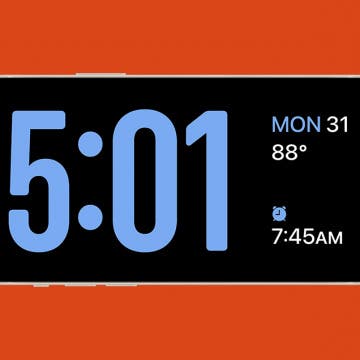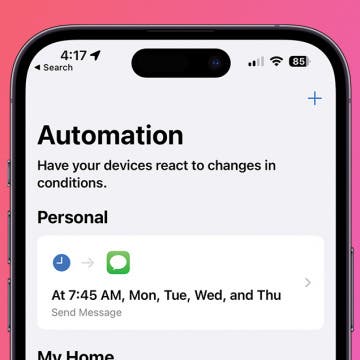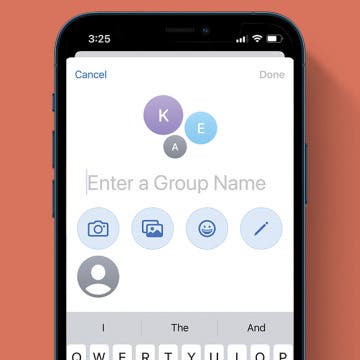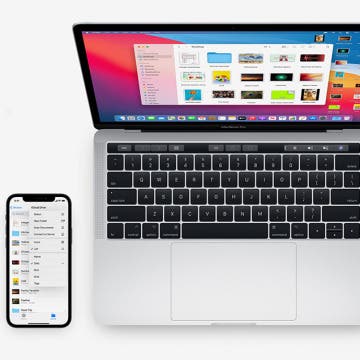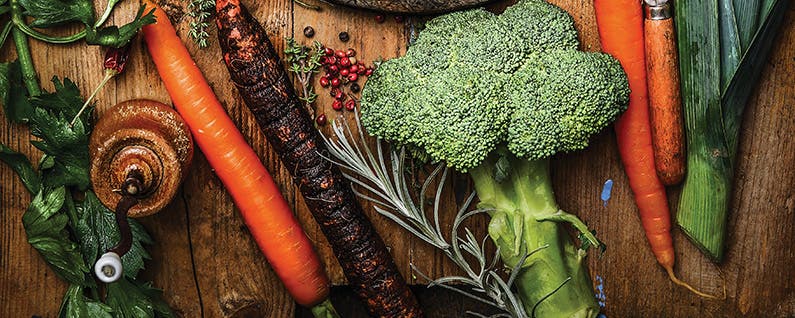
The following article was witten by Steve Boss and published in the Summer 2016 issue of iPhone Life magazine. Learn how to get the most from your iPhone by clicking here to subscribe.
Inside a floor-to-ceiling windowed kitchen laboratory and office space located in Seattle’s iconic Pike’s Place Market, you’ll find Grant Crilly and Chris Young, two chefs who both received their training from three-Michelin-starred gastronomical luminaries. Together, Crilly and Young have created their own cooking academy, combining equal parts passion, generosity, determination, craftsmanship, scientific curiosity, and technology to create their small business known as ChefSteps.

So what are the ingredients for creating such a unique company? First, blend in to the mix Chief Technology Officer Michael Natkin (who in addition to spending 13 years as an engineer at Adobe, is a well-known blogger and cookbook author) and Emmett Barton (former team leader at Amazon who redesigned the Kindle bookstore for Kindle Fire tablets). Next, garnish with world-class designers, videographers, and marketers, and top it off with more than a drizzle of input from a growing vocal community of a million users. The result: a James Beard Award-winning company, where a culinary revolution began in 2012 and is still cooking today.
The company’s manifesto is simple, according to Crilly, “No matter your culture, age, or gender, everyone in the world speaks the same universal language of food. Our job is to give people a better experience in the kitchen; to assist the home cook in unlocking the innate power of the kitchen so they become empowered. Move them from ‘I don’t cook,’ or ‘I don’t know if I want to cook,’ to ‘I didn’t know cooking could be this fun.’”
What Sets ChefSteps Apart
 My first taste of ChefSteps hooked me. I broke out into hysterical laughter while watching "Waffle Iron Frenzy!," a we’re-not-responsible-if-you-do-this-at-home-style video that the staff put together involving a waffle iron and a bunch of random ingredients—including a Mexican casserole that belonged to a coworker. From there, I continued to consume videos and tips, from which I learned how to properly mince a shallot, freeze fresh herbs into tiny flavor cubes, and make homemade ketchup. I even seasoned my grill ChefSteps-style and toasted some buns on it as instructed. The ChefSteps website and corresponding app feature hundreds of free recipes infused with step-by-step instructions, photos, and videos. From their desktop or mobile device, users can access classes on knife sharpening, barbecuing, candy making, and spherification. The website even offers a forum, providing a focal point for community interaction where users can ask questions and contribute recipes.
My first taste of ChefSteps hooked me. I broke out into hysterical laughter while watching "Waffle Iron Frenzy!," a we’re-not-responsible-if-you-do-this-at-home-style video that the staff put together involving a waffle iron and a bunch of random ingredients—including a Mexican casserole that belonged to a coworker. From there, I continued to consume videos and tips, from which I learned how to properly mince a shallot, freeze fresh herbs into tiny flavor cubes, and make homemade ketchup. I even seasoned my grill ChefSteps-style and toasted some buns on it as instructed. The ChefSteps website and corresponding app feature hundreds of free recipes infused with step-by-step instructions, photos, and videos. From their desktop or mobile device, users can access classes on knife sharpening, barbecuing, candy making, and spherification. The website even offers a forum, providing a focal point for community interaction where users can ask questions and contribute recipes.
The current ChefSteps app is free of bells and whistles, featuring a simple collection of recipes (with new ones added every week) and an egg calculator for cooking your eggs to perfection. A user can browse image after beautiful image of various dishes, complete with recipes and instructions when you tap on the photo. A recent addition to the web program is a premium user option available for a nominal one-time fee of $25. It provides access to special in-depth classes on topics like cooking French macaroons and learning the basics of fluid gels and whipping siphons.
My hunger unquenched, I called the ChefSteps office and arranged an interview with Crilly for my weekly radio show, Great Taste. From the moment we started talking, Crilly’s sincere commitment to assisting home cooks was apparent. He explained how the team was already working on expanding the uses of the app. “We know that a lot of our audience skews more technically savvy,” he commented. “They want the ability to take all the information with them, and the app lets you build in more dynamic experiences than on a web browser.”
The company’s internal process of content creation is dynamic and fluid. Initially, recipes sprung from whatever ingredients and techniques excited Young and Crilly. Now, every Monday, the entire creative team gets together to build an editorial calendar. They review data on what users are viewing, and read every posted comment from the ChefSteps community, including those on Facebook and YouTube. Discussion ensues, and the team works to sift through the more extreme requests, balancing that group’s needs with the desire to post content that will actually help the most people attain a higher level of cooking experience.
Another critical ingredient in this process is the singular creative perspective typified by each team member. For example, Young contributes the scientific element based on his degrees in theoretical mathematics and biochemistry, while Natkin’s culinary sense and software engineering knowledge make him a voice of reason in the kitchen when it comes to what is or is not possible to achieve. Recently, the team reimagined the use of the video component that accompanies most recipes, drilling down to actually considering each second. “We’re gearing toward ‘just in time’ learning,” said Barton. “It’s not practical in the chaotic atmosphere of the kitchen to have long videos. The video experience needs to be minimal, but impactful.”
This new direction won’t put a damper on the humor and irreverence that are hallmarks of ChefSteps videos. “We’re trying to identify with folks and help them understand where cooking techniques before may have seemed confusing or mysterious, they are really straightforward,” Crilly remarked. “You want the videos to be a little fun to lighten people up.”
The Launch of a New Product

By mid-2016, the team is launching its first hardware product: Joule. Joule is a water circulation device that holds liquid at a steady temperature. Foods—meats, fish, vegetables, dairy products—are placed into a plastic bag or mason jar, submerged into a water bath, and then, using Joule,are cooked at remarkably low temperatures. The technique, known as sous vide, has been used primarily at fine dining restaurants since 1974, but is relatively new to the home cook.
“Sous vide is an incredible advancement in the kitchen that allows people to achieve textures and results that were previously impossible,” said Crilly. “Very few tools can guarantee a specific outcome, but with sous vide the end result is a better-tasting steak, chicken breast, vegetable—whatever.”
I swallowed the sous vide Kool-Aid and tried the chicken breast recipe first. I was immediately sold, but I needed validation. Although the texture and taste were like no other chicken I had ever eaten, I was skeptical of my bias. Perhaps I had recklessly tossed some hallucinogens into the bag with the chicken? I called some neighbors in for a taste test. Watching and listening to their reactions assured me my culinary life would never be the same.
The next day I tried the sous vide recipe for salmon. Stunning. I have had wild salmon fresh from the river in Oregon and a horseradish-crusted salmon over 25 years ago in Manhattan at The Westbury’s Polo Lounge that I can still taste. But this piece of salmon, which had resided for some time in my freezer and was seasoned simply with a little olive oil, salt, and pepper, took its place alongside those other treasured food memories.
The Value of Simplicity
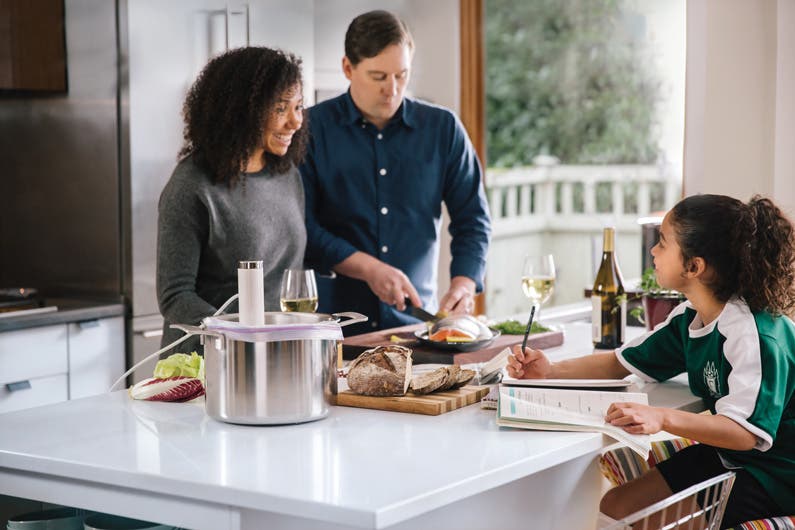
As Crilly and I continued our discussion, he laid out his vision for a tool kit brimming with apps. “We want to go in that direction because it is a real refl ection of how the kitchen is organized,” he said. “You pull out a certain tool when you need it. In my mind, there is a cleaner experience if you limit the type of work the app has to do. It’s also easier to build, and the result is a more joyous user experience.”
What really separates ChefSteps from the myriad of other cooking apps available in the App Store is in how the team bottles instruction with the cardinal principle inherent in hospitality—a total commitment to customer satisfaction. Every grain of content refl ects the desire of its visionary chefs to spend their waking hours cooking for others, and help their user community cook for family and friends.
When I asked Crilly if there was a defi ning moment for him that captured the essence of the company’s mission, he told me a story about a couple, Ryan Jones and Jaci Mayer. Ryan is an admitted ChefSteps geek. The fi rst time Ryan cooked for Jaci he used recipes from the site to teach her about emulsions. ChefSteps became the lynchpin in their relationship, and “…it’s your videos,” Jones wrote Crilly, “that really transformed her appreciation for food into something more.”
Acting on a whim, Jones emailed Crilly and asked if the ChefSteps team might allow him to propose to Mayer at their headquarters in Pike’s Place during a meal prepared by the ChefSteps crew. Fast forward to October 9, 2015, where during dessert Jaci accepted Ryan’s surprise proposal. There wasn’t a dry eye in the kitchen. “I’m just willing to do whatever it takes to help out cooks at home,” said Crilly. “The important part is presenting a pathway to the user that is clear and not stressful so people can move up to more challenging projects, learn more, and have fun in the kitchen.”
Or use ChefSteps as a springboard to marriage.




